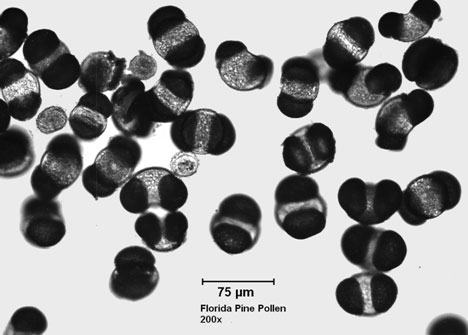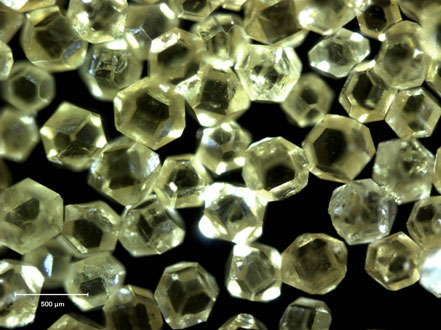"Everything is a particle!" - Wallace H. Coulter
The definition of particle is very different based on the discipline and perspective we are looking at them.
Here, we define a particle as a small discrete quantity of matter that has an interface with the surrounding environment. Most often particles are associated with solid materials that have an interface with an enveloping gas or liquid. However, particles might just as easily be liquid droplets in air, bubbles in water or emulsions. There is no rule governing how large or small an object must be to be considered a particle. Some define particles as ranging from one nanometer to one millimeter. Some place no size restriction at all - a heavenly body such as a planet or a star might be considered to be a very large particle. However, particle scientists generally leave the astronomical bodies and the molecular or sub-atomic particles to astronomers and physicists.
Why do we study Particles?
There are three qualities of particles that make them unique and worthy of their own field of scientific investigation.
- The first is the interfacial properties of particulate systems. As particles become very small and large in number, particle systems will exhibit very large surface areas in relation to their mass. The interface between the particle and its environment displays properties that are markedly different from the bulk material. Particle Technologists take advantage of these surface properties for a wide range of applications such as: paints, coatings, catalysts, taste and texture, dessicants, adsorbents, rapid dissolution, abrasives, cutting tools, composite materials, ceramics and powder metallurgy.
 The second quality is that materials in particulate form (e.g. powders, slurries, droplets, emulsions) can often be handled, transported and processed with greater ease and economy than the same materials in bulk forms. For example, minerals are generally ground or milled to facilitate their transport, and to aid in separating and processing the desirable elements. Pharmaceuticals are widely processed as powders to create tablets with the right dosage of medication in an easily administered form (pills).
The second quality is that materials in particulate form (e.g. powders, slurries, droplets, emulsions) can often be handled, transported and processed with greater ease and economy than the same materials in bulk forms. For example, minerals are generally ground or milled to facilitate their transport, and to aid in separating and processing the desirable elements. Pharmaceuticals are widely processed as powders to create tablets with the right dosage of medication in an easily administered form (pills).- The third quality arises, as particles get so small that their size approaches molecular dimensions. At length scales of a few nanometers fundamental structural, electronic and optical properties of some materials begin to change giving rise to entirely new properties and sometimes quite unusual phenomena. Examples of these novel properties include carbon nanotubes with a hundreds of times the theoretical strength of steel and an electrical current density a 1000 times greater than that of copper or silver, semiconductor quantum dots that emit light at different wavelengths corresponding to their nano-size, and superparamagnetic properties of some nano-powders.
The study of particles at sizes below about 100 nanometers is part of the science of nanotechnology. In this size regime, many exciting properties begin to emerge along with many difficulties relating to the handling and dispersion of particles. As particles get smaller, attractive forces (Van der Waals) begin to dominate and particles become more likely to agglomerate into larger structures. For Particle scientists desiring to use nanomaterials in a dispersed state this can be a difficult problem but in the natural world this is fortunate indeed. If it were not for this quality, we might be living in a world submersed in a sea of nanoparticles!
One of the major consequences of reducing particle size is the increase in interparticle forces with respect to particle mass. This phenomenon manifests itself as greater cohesiveness in very fine powders and a tendency to aggregate in colloidal solutions. An example of this is the difference in the flow properties of wheat kernels versus wheat flour. The relatively large wheat kernels have a large mass in proportion to their surface area and the interparticle attraction. Thus, they are easily separated from one another as individual grains. The same mass of flour on the other hand, has a much higher surface area and individual particles have a much smaller mass. Thus, flour particles tend to stick together or "clump". Moisture or humidity exacerbates this tendency by adsorbing onto the surface and adding additional attractive forces. This has great significance in industrial and other technological applications of powders and colloids. Though we often wish to use very fine particles for their high surface area and interfacial properties, keeping the particles free flowing or dispersed in a colloidal suspension can be a significant challenge which remains to this day as much an art as it is a science.
 In Nature, particles exist everywhere we turn, sometimes in desirable forms (beach sand, fertile soil, alluvial plains, clays, pollen, fog, rain or snow) and sometimes undesirable forms (volcanic ash, dust, smoke, mud, hail). Sometimes it depends on one's perspective (e.g. pollen, fog, rain or snow). Biological organisms consist of a wide variety of particles, cells, proteins, viruses, microbes, seeds, etc. with a tremendously complex set of interactions that govern all life on earth.
In Nature, particles exist everywhere we turn, sometimes in desirable forms (beach sand, fertile soil, alluvial plains, clays, pollen, fog, rain or snow) and sometimes undesirable forms (volcanic ash, dust, smoke, mud, hail). Sometimes it depends on one's perspective (e.g. pollen, fog, rain or snow). Biological organisms consist of a wide variety of particles, cells, proteins, viruses, microbes, seeds, etc. with a tremendously complex set of interactions that govern all life on earth.
 Manmade particles and particulate systems have been a tremendous boon to the advance of our civilization and are studied to advance technology, improve our health and welfare and help preserve our environment. However, incidental particles are often created in the process that can be detrimental to human health and the environment. Incidental particles such as particulate emissions from combustion, water pollution, mineral tailings and other waste from industrial processes are studied by particle scientists to eliminate or mitigate such adverse effects.
Manmade particles and particulate systems have been a tremendous boon to the advance of our civilization and are studied to advance technology, improve our health and welfare and help preserve our environment. However, incidental particles are often created in the process that can be detrimental to human health and the environment. Incidental particles such as particulate emissions from combustion, water pollution, mineral tailings and other waste from industrial processes are studied by particle scientists to eliminate or mitigate such adverse effects.
Particles are indeed everywhere from our kitchens to the remotest parts of our world. Because of their ubiquity, we often don't take the time to consider the unique properties and impact of particles in our lives. The role of particle technologists is to study particulate systems to find new or better ways to advance technology and preserve human health and the environment for future generations.